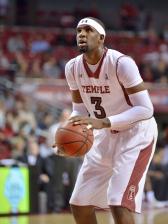March Madness: How to Motivate Like a Pro Athlete
March Madness is here! The Public Speaker shows us how to give a great motivational “pre-game” speech.
Lisa B. Marshall
Listen
March Madness: How to Motivate Like a Pro Athlete
The NCAA tournament, otherwise known as March Madness, is always full of big moments. Little teams knock out powerhouse teams. Impossible shots are made to win a game at the buzzer.;

To prepare for this episode, I watched a lot of YouTube videos of athlete speeches. I watched videos of legendary coaches like UCLA’s John Wooden.
I watched a great clip from the movie Hoosiers, where Gene Hackman plays high school basketball coach Norman Dale and gives one of the most well-known basketball speeches of all time.
I even watched controversial coach Bobby Knight give a speech that was so full of expletives I’m not even sure what he said. His brand of motivation was not one I would recommend.
One speech clearly stood out to me. It followed some of my favorite public speaking rules, but also sparked my creative juices.
This speech was given by the Baltimore Ravens’ Ray Lewis (yes, I know that’s football). Ray Lewis walked into the locker room of the Stanford Cardinals and gave them one heck of an inspirational speech before their tournament game. Ray Lewis is known for getting his own team fired up, but the ability to inspire another team requires some strong speaking skills. Let’s look at how he did it:
Tip #1: Use the Element of Surprise
If you really want to motivate your team, bring someone else in to do it. They’ve probably heard what you have to say more than once. They’re expecting you to try to inspire them. When I worked in the corporate world, our company would occasionally bring in a surprise celebrity to start off our annual meeting. This got our attention and brought us back to our seats from the snack line.
When legendary football player Ray Lewis walked in to the Stanford Cardinals’ locker room, the mood picked up right away. He greets the players one at a time and after the initial shock, the players start laughing and clapping and you can see the excitement start to build. The team is fired up before their guest speaker even opens his mouth because he has already made a connection.
Tip #2: Start with a Question
Ray Lewis thanked the team for the opportunity to speak to them, signaling he was ready to begin. As soon as the team went quiet, he started with a question, then a group of follow-up questions. This gave his audience something to focus on:

“If tomorrow wasn’t promised, what would you give for today?
Forget everything else. Forget everything else. Forget that there was any sunlight left. What would you spend today thinking about. Yourself? Or the man that’s beside you? Or the man that you know you’d give everything in your heart for?”
Tip #3: Use “You” to Make it Personal
The pronouns you use in a motivational speech are important. Too much “I” turns a speech into a story about the speaker. “They” is impersonal. The more you use the pronoun “you,” the more personal it will feel to the group. At a rough count, I see the words “you,” “your,” and “you’re” used 19 times in this speech.
Tip #4: Repeat Key Words to Make them Stick
Lewis wants to motivate the team to give their best effort. How does he do it? He repeats the word “effort” multiple times:
“Wins and losses come a dime a dozen. But effort? Nobody can judge effort. Effort is between you and you. Effort ain’t got nothing to do with nobody else.”
If this team walks away remembering one thing, it will probably be the word “effort.”
Tip #5: Back up Your Words with Body Language
If you get a chance, watch the video of this speech and pay attention to Ray Lewis’s body language. His arms move with his words. When he gives a word emphasis, his hands do too. As his voice picks up in intensity, so do his body movements. You could even argue that his hand gestures and body language are even more motivational than his words.
Tip #6: Use the Rule of 3
“Forget everything else. Forget everything else. Forget that there was any sunlight left.”

Lewis uses three phrases in a row that start with the word “forget.” This is an excellent use of the rule of 3. It also uses a figure of speech known as “anaphora.” Anaphora means to start two or more phrases in a row with the same word.
Tip #7: Vary Your Pitch, Volume, and Speed
If you watch the video, you’ll see how Lewis uses variations in pitch, volume, and speed to change the tone of his message. When he begins, his pitch is low, his volume is quiet, and his speed is slow. By the end, his pitch, volume, and speed have all increased dramatically. This gradual vocal build-up is how you build the energy of your listener.
Tip #8: Keep it Short
I mentioned before that I watched several different motivational speeches. Since I was watching them on YouTube, I could see the length of the speech. I kept looking for something longer than 1-3 minutes, but I couldn’t find anything.
Then it hit me: Motivational speeches need to be short.
A 1-3 minute speech is really about all you can expect a team to listen to right before a big game or just before a big event at work. As public speakers, we can learn a lot from half-time speeches or locker room talks. If you haven’t watched the Ray Lewis video yet, you can find it Click here for information. Now, good luck with your March Madness bracket!
This is Lisa B. Marshall, Helping you maximize sales, manage perceptions, and enhance leadership through keynotes, workshops, books, and online courses. Passionate about communication; your success is my business.
Have you listend to my new podcast, Smart Talk? If not why not? I wnt to strongly encourage you to head on over to smarttalksuccess.com. This past week I interviewed Dan Schawbel and Linda Descano. Dan and I talked about early career development and Linda and I talked about later career development. Linda is a very senior leader at Citi and Dan is a bestselling author. Listen to Smart Talk: Inspiring Conversation with Exceptional People by visiting smarttalksuccess.com.
Resources
Ray Lewis’ speech to Stanford basketball team
Transcript of Ray Lewis’ speech

